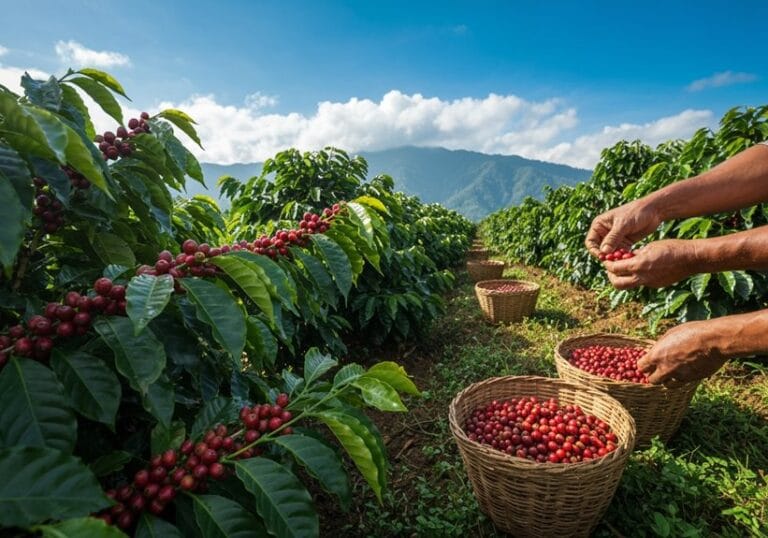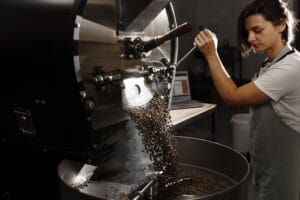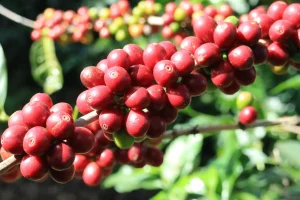In terms of coffee harvesting, there are a few methods that really stand out! You’ve got selective picking, where only the ripe cherries are chosen—talk about a cherry pickin’ dream! Then there’s strip picking, which is like playing musical chairs with cherries, grabbing everything at once and dealing with the mess later. Machine harvesting zips through fields faster than a squirrel on caffeine. And don’t forget those nifty handheld vibrating machines, shaking the cherries like maracas. Curious about how each method affects flavor? Keep on!
Key Takeaways
- Selective picking involves hand-picking only ripe cherries, ensuring high-quality coffee by avoiding under-ripe fruit.
- Strip picking gathers all cherries rapidly, mixing ripe and unripe, which requires sorting afterwards.
- Machine harvesting utilizes mechanization for quick and efficient cherry collection, reducing labor costs and time.
- Derricadeiras are handheld vibrating machines that gently harvest only ripe cherries, minimizing waste while easing labor strain.
- Each harvesting method affects the quality of coffee and the revenue potential for farmers, emphasizing the importance of method selection.
Selective Picking (Hand-Picking)
In the matter of picking coffee, you might think it’s just a matter of yanking off a bunch of cherries, right? Ha! Enter selective picking—this is a hands-on, intimate dance with each cherry!
Imagine picking only the brightest red ones while leaving the green stragglers to mature. That’s right, it takes a skilled eye and some quick decisions, folks!
Picture traversing steep hills, your hands moving like crazy to snag the sweet ones, and—voilà!—you’ve got the end result: higher-quality coffee. This method, known as selective harvesting, ensures that only fully ripe cherries are picked, preserving the best flavors. By employing this technique, farmers can benefit from an increased production fertilization that ultimately enhances the overall quality of their beans.
Seriously, every little cherry counts, and here’s the kicker: fewer under-ripe cherries mean less bitterness. Yep! It may be more labor-intensive and a bit pricier, but when that coffee hits the cup, you’ll know it was worth every labor-intensive moment!
Strip Picking (Hand Stripping)
Strip picking, oh boy, it’s the wild rollercoaster ride of coffee harvesting! Imagine this: you grab a branch and yank off all those coffee cherries in one go!
Strip picking is like a wild rollercoaster of coffee harvesting—grab a branch and yank off all the cherries!
This method, while super quick for coffee picking, doesn’t care if the cherries are ripe or not—so expect some serious sorting later. Here are some fun facts about strip picking:
- It’s speedy! Harvesters can fill buckets fast, especially in places where cherries ripen together, like Brazil.
- Ripe cherries can get squished, which isn’t good for coffee quality. Oops!
- Trees only need light pruning, so, less hassle there compared to machines!
Machine Harvesting
While many farmers wrestle with the backbreaking work of handpicking cherries, mechanized harvesting steps in like a superhero wearing a shiny cape, zooming through coffee fields with the speed and efficiency that leaves everyone else in awe!
Imagine this: machine harvesting can kick some serious butt, knocking out a job in just 26 minutes—compared to the 50 minutes of manual labor! It’s like a race car versus a tricycle.
These machines can tackle about 0.0831 hectares per hour. Sure, they might not be perfect in all terrains, but on those flatter fields? Game on!
And hey, less strain for farmers means happier backs, right? With lower costs and high yields, it’s no wonder these machines are getting all the coffee love!
Derricadeiras (Handheld Vibrating Machines)
Derricadeiras are like the trusty sidekicks of the coffee harvesting world, swooping in to save the day with a more gentle touch than their larger machine cousins.
Derricadeiras: the gentle heroes of coffee harvesting, providing precision and care where larger machines can’t.
These nifty handheld vibrating machines, powered by petrol, let operators shake ripe coffee cherries loose without wrecking the branches. You know, it’s like a gentle handshake—just not too firm!
Key features include:
- Precision: They target only the ripe cherries, reducing waste!
- Portability: Easy to maneuver in tricky terrains—unlike that clunky old machine in the shed.
- Efficiency: Quicker than pure handpicking, cutting down on that back-breaking labor.
While they can save time, workers still have to hustle to gather fallen jewels (or cherries, in this case).
Frequently Asked Questions
How Does Coffee Harvesting Impact Environmental Sustainability?
Coffee harvesting greatly impacts environmental sustainability by contributing to deforestation, greenhouse gas emissions, and soil degradation. Unsustainable practices compromise biodiversity and water quality, while sustainable methods like shade-grown cultivation help mitigate these negative effects.
What Is the Average Yield per Method of Coffee Harvesting?
The average yield per method of coffee harvesting varies, with one-time harvest typically yielding higher estimates due to direct counting, while allometric methods produce lower but non-destructive estimates, often requiring skilled labor to guarantee accuracy.
How Does Cherry Ripeness Affect Coffee Flavor Profiles?
Cherry ripeness greatly impacts coffee flavor profiles; fully ripe cherries improve sweetness and complexity, while underripe or overripe cherries can introduce undesirable flavors. Ideal ripeness guarantees a balanced sugar and acid composition, essential for desirable taste.
What Skills Are Essential for Successful Coffee Cherry Pickers?
Essential skills for successful coffee cherry pickers include the ability to distinguish cherry ripeness, manual dexterity for precision, stamina for repetitive tasks, equipment handling knowledge, attention to detail for sorting, and adherence to safety protocols.
Are There Any Health Risks Associated With Coffee Harvesting Methods?
Yes, health risks associated with coffee harvesting methods include pesticide exposure, respiratory illnesses from airborne chemicals, and potential mycotoxin contamination. These hazards affect both workers’ health and the surrounding ecosystem, prompting concerns for local communities.





